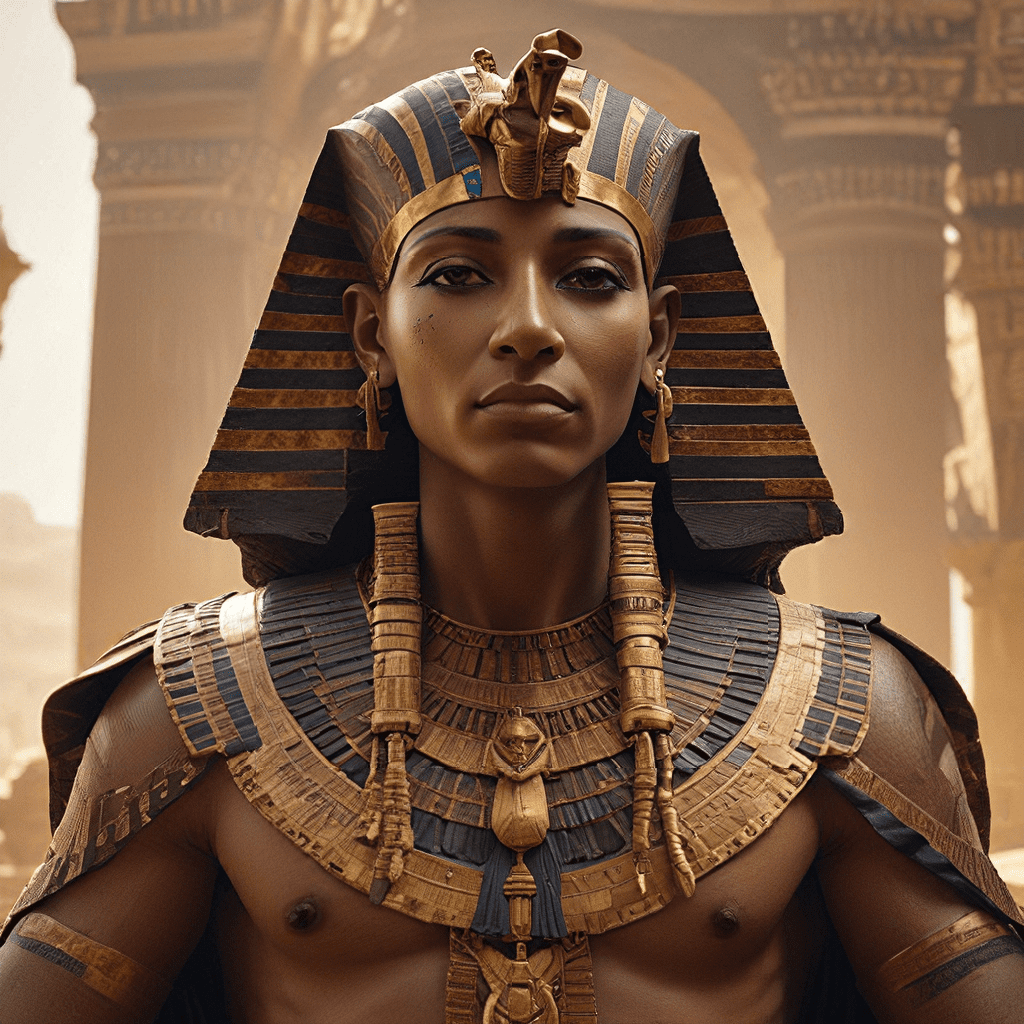1. Introduction: The Pharaohs – Divine Rulers of Egypt
Ancient Egypt, a civilization renowned for its magnificent pyramids, intricate hieroglyphics, and enduring legacy, was ruled by Pharaohs, who were more than just kings; they were considered divine rulers. The Pharaoh’s power and authority stemmed from a profound belief in their divine right to rule, a concept intricately woven into the fabric of Egyptian religion and society. This essay delves into the complex relationship between kingship and religion in ancient Egypt, exploring how the Pharaoh’s status as a god-king shaped their role in society, the rituals they performed, and the artistic representations that immortalized their divine nature.
2. The Divine Origins of Kingship: The Pharaoh as a God-King
The ancient Egyptians believed that the Pharaoh was not merely a mortal ruler but the living embodiment of Horus, the god of kingship. According to Egyptian mythology, Horus was the son of Osiris, the god of the underworld, and Isis, the goddess of magic and motherhood. Horus was believed to have avenged his father’s murder by defeating Seth, the god of chaos, and thus restoring order to the universe. The Pharaoh, as the successor to Horus, inherited this divine lineage and was seen as the embodiment of cosmic order and justice.
The Pharaoh’s divine status was further reinforced by the myth of the creation of the pharaohs. According to this myth, the god Ra, the sun god, created the first Pharaoh, who was bestowed with divine power and the right to rule. The Pharaoh’s lineage was believed to be directly connected to Ra, making them the rightful heirs to the throne and the guardians of the divine order. This belief in the Pharaoh’s divine origins gave them an almost supernatural authority, justifying their absolute power and their responsibility to maintain cosmic balance.
3. The Pharaoh’s Role in Maintaining Cosmic Order
Beyond being a political leader, the Pharaoh was also seen as the intermediary between the human and divine realms. They were responsible for maintaining Ma’at, the cosmic order, which encompassed justice, harmony, and balance in the universe. This responsibility was not just symbolic; it was deeply intertwined with the Pharaoh’s religious duties and rituals.
The Pharaoh performed a variety of rituals and ceremonies to ensure cosmic balance. These rituals included offerings to the gods, prayers for a bountiful harvest and protection from natural disasters, and the construction of temples and pyramids to house the divine. The Pharaoh’s role in maintaining Ma’at was seen as essential for the well-being of both the human and divine realms. Failure to uphold the cosmic order was believed to lead to chaos, misfortune, and even the wrath of the gods.
4. The Pharaoh as the High Priest and Religious Authority
The Pharaoh was not merely a ruler but also the High Priest of Egypt. They had the ultimate authority over religious matters, overseeing the construction and maintenance of temples, conducting religious ceremonies, and ensuring the well-being of the gods. Their role as the High Priest solidified their connection to the divine and emphasized their responsibility to act as the intermediary between the gods and the people.
The Pharaoh’s religious authority was also reflected in their influence over religious beliefs and practices. They played a crucial role in shaping the Egyptian pantheon, promoting certain deities and establishing their importance in the religious hierarchy. Their actions in the religious sphere further solidified their power and ensured their legitimacy as the divine rulers of Egypt.
5. The Symbolism of Pharaoh’s Power: Artistic Representations and Royal Regalia
The divine nature of the Pharaoh was also emphasized through artistic representations and royal regalia. Pharaohs were often depicted in art as divine figures, often standing alongside gods and goddesses. They were typically shown wearing the double crown, a symbol of their power over Upper and Lower Egypt, and other royal regalia such as the crook and flail, representing their authority as shepherds and rulers of their people. These symbolic representations served as visual reminders of the Pharaoh’s divine status and their connection to the cosmic order.
The use of symbolism in royal imagery was a powerful tool for reinforcing the Pharaoh’s divine right to rule. From the majestic pyramids to the intricate hieroglyphics, every aspect of Egyptian art and culture was permeated with the idea of the Pharaoh’s divine nature. This deliberate use of symbolism ensured that the Pharaoh’s divine status was never forgotten and served as a powerful tool for maintaining their authority.
6. The Pharaoh’s Relationship with the Gods: Offerings, Prayers, and Temples
The Pharaoh’s relationship with the gods was characterized by a sense of duty and obligation. They were responsible for providing for the gods through offerings and sacrifices, ensuring their well-being and maintaining their favor. The Pharaoh would also offer prayers to the gods, seeking their blessings and protection for the kingdom and its people.
The construction of temples was another essential aspect of the Pharaoh’s relationship with the gods. Temples were not merely places of worship; they were considered the homes of the gods, and the Pharaoh was responsible for their construction and maintenance. These temples served as a visible reminder of the Pharaoh’s divine connection and their commitment to the gods. The Pharaoh’s role as a builder of temples ensured their legacy as divine rulers and their enduring connection to the gods.
The Pharaoh’s relationship with the gods went beyond mere formality. It was a relationship built on respect, reverence, and the understanding that the Pharaoh’s power and authority were derived from the divine. The Pharaoh’s devotion to the gods was seen as essential for maintaining cosmic order and ensuring the prosperity of the kingdom.




